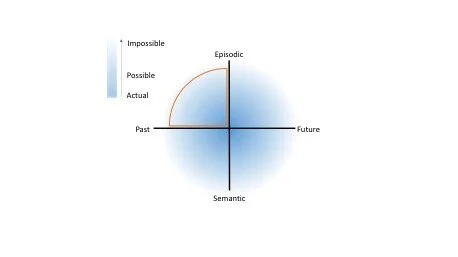Felipe De Brigard is Associate Professor in the departments of Philosophy, Psychology and Neuroscience, and the Center for Cognitive Neuroscience at Duke University. He’s the principal investigator of the Imagination and Modal Cognition lab (www.imclab.org) associated with the Duke Institute for Brain Sciences. His research concerns memory, imagination, and moral cognition, and has been published in philosophical, psychological, and neuroscientific venues.
A post by Felipe De Brigard.
For the past few years, my lab has been doing research on what we call episodic counterfactual thinking (eCFT): our psychological capacity to imagine alternative ways in which past personal events could have occurred. For instance, when I recall choosing the wrong answer in a multiple-choice exam and, upon retrieval, imagine instead picking the right one, I am exercising eCFT. In this entry I would like to draw attention to a recent theoretical piece, published in collaboration with Dr. Natasha Parikh, in which we tried to characterize eCFT by contrast to related mental simulations varying along three dimensions: temporal context, degree of episodic detail, and modal profile. In that piece, we argue that extant empirical evidence strongly suggests that, while related along these three dimensions, eCFT may be a psychological process different from episodic memory (eM), episodic future (eFT), and semantic counterfactual thinking (sCF). This entry is an abridged version of our piece, which can be found here.
Temporal dimension
Like eM, eCFT is retrospective: the imagined alternative events are mentally located in the past. However, eCFT is about hypothetical, not actual, events. In that sense, eCFT is similar to eFT, which involves the mental simulation of possible events that may occur in the future. However, unlike eFT, eCFT is about possible events that could have been in our past, not that may be in our future. Thus, eCFT shares with eM the fact that both depict events in a subjective past, while it shares with eFT the fact that it involves the mental simulation of merely possible (i.e., non-actual) events.
Early work showing overlap in cognitive and neural mechanisms underlying eFT and eM led theorists to suggest that both are processes of a single cognitive system for mental time travel. The problem is that this view renders mental time travel surprisingly asymmetric: while eM is constrained by what actually happened in the past, eFT is not so constrained. However, early neuroimaging papers exploring eCFT showed that core regions of the brain’s default network (DN), critical for eM and eFT, are also recruited when we imagine not actual but possible past events. Neuropsychological evidence from schizophrenics, amnesics, and individuals with damage in ventromedial prefrontal cortex, all of whom show deficits in eM and eFT, indicates that they also exhibit deficits in eCFT. Moreover, behavioral and phenomenological commonalities between eCFT, eM, and eFT have also been documented using several methods, including self-report scales and different narrative coding strategies. Finally, developmental evidence also suggests similar age-related trajectories across all three mental simulations, both in children and older adults.
Despite their similarities, there are important differences between eCFT and both eM and eFT. For instance, eM are experienced with more sensory details and better spatial composition than eFT and eCFT, while eCFT are experienced with less emotional intensity than eM and eFT. Similarly, the perceived plausibility of eCFT and eFT is differentially affected by repeated simulation, and also, when individuals generate both eCFT and eFT to improve upon past performance, they tend to focus on different elements of their simulation depending on whether it is placed in a possible past or a possible future. Finally, neural differences have been reported too, suggesting that despite their similarities, eCFT differs from eM and eFT, and these differences may warrant considering it as a related yet separate construct.
Episodic dimension
While eM involves the generation and maintenance of concrete spatiotemporal episodes from our past, semantic memory does not. Likewise for counterfactual thinking. On one extreme, we can entertain an almost eM-like counterfactual thought. On the other extreme, we can think of semantic-like counterfactuals, as when we entertain thoughts involving general knowledge (e.g., what if water boiled at 90 degrees Celsius?). Thus, eCFT—which tends to be similar to, and based on, eM—stands in contrast to semantic counterfactual thinking (sCFT), which tends to be similar to, and based on, semantic memory.
Earlier research on counterfactual thinking employed vignette- and task-based materials that tended to be impersonal and non-autobiographical. But recent results suggest that what people mentally mutate depends on whether or not they were the agents of the action. In a 2015 paper, my colleagues and I explored a possible explanation for this agent/context asymmetry. In this study, we asked participants to engage in counterfactual thinking either about themselves or about objects while undergoing fMRI. We found that while object-based counterfactuals tended to recruit brain regions associated with semantic memory, self-based counterfactuals tended to recruit core regions of the DN. More recently, we directly compared eCFT versus sCFT in an fMRI study and corroborated preferential engagement of DN during eCFT as opposed to sCFT. Finally, there is some developmental evidence suggesting differential trajectories in the emergence of eCFT relative to sCFT.
It is worth emphasizing that eCFT and sCFT do not constitute two entirely different and dichotomous psychological categories, but rather two extremes of a continuum, so that different simulations can engage relatively more or less cognitive processes of certain sorts. Our suggestion is that episodic and semantic memory processes are differentially engaged depending on whether a mental simulation is closer to eCFT—in which case episodic details are required to generate it—or closer to sCFT, in which case semantic information helps to scaffold the counterfactual thought.
Modal dimension
Unlike eM, when we engage in eCFT we are not constrained by what actually happened. Even if we admit some degree of inaccuracy in our memories, remembering implies an attempt to generate mental simulations that approximate an actual past event. When we engage in eCFT though, we know that what we imagine did not happen—although it could have, with some degree of possibility. Thus, the third dimension of eCFT is modal: eCFT varies from the almost-actual to the almost-impossible. Often, when we imagine variations to actual past personal events we tend to minimally deviate from what actually occurred, which in turn often (but not always!) leads us to think that these close alternatives were not only possible but plausible as well. However, sometimes we let our minds wonder far beyond the plausible what-ifs and find ourselves dreaming-up almost impossible scenarios that bear little resemblance to what actually happened in our life. And to complicate things, often the amount of change required to alter an event need not correlate with how plausible it would have been for the imagined counterfactual to have occurred instead.
Of the three dimensions, the modal one is the least well understood and, in the case of eCFT, the least studied. Work employing vignette-based sCFT suggests, for instance, that participants are more likely to reason counterfactually about events that deviate from norms, that involve actions rather than inactions, or that are causally close rather than distant from a desired outcome. Interestingly, it has been shown that even the initial selection of the alternatives we entertain when reasoning counterfactually are constrained by moral considerations, such that we are less likely to consider as possible a counterfactual event we deem immoral rather than a moral one. Neuroimaging evidence also shows differences in brain activity as a function of perceived plausibility, with increased recruitment of core regions of the DN for eCFT perceived as plausible versus implausible. These and related results suggest, therefore, that how plausible we think a counterfactual event is may depend on the extent to which we see it as immoral, abnormal, salient and/or easy to imagine.
However, it is likely that at least some factors that influence our judgments of possibility in eCFT are common to other forms of counterfactual simulation. It has been suggested, for instance, that counterfactual thinking involves the generation of a mental model and its juxtaposition to a mental template which, in the case of eCFT may be an autobiographical eM. In turn, the degree of similarity between the counterfactual model and the template may modulate the extent to which we think of it as more or less plausible. Evidence in favor of this idea comes from a recent study suggesting that repeatedly simulating an eCFT may bring out more dissimilarities between the original autobiographical memory and the eCFT, which in turn reduces the perceived possibility of the latter. Studies employing sCFT also show strong correlation between the perceived similarity between the actual and the counterfactual event and their perceived possibility. Finally, there seem to be important commonalities between eCFT and sCFT perceived as possible at the neural level, as a recent study reports increased hippocampal activity for both kinds of simulation as a function of perceived possibility, a result that contrasts a similar study showing reduction of hippocampal activity as a function of perceived possibility in eFT. While further research is needed to fully understand the extent to which perceived possibility and impossibility differs between eCFT and sCFT, we think that extant evidence suggests that the modal profile of eCFT is to a certain extent independent of that of sCFT and eFT.
Conclusion
We have argued that autobiographically-based counterfactual thoughts that are episodic-like, retrospective, and perceived somewhere in a continuum from possible to impossible form a coherent psychological construct conveniently denoted by the notion of eCFT. Moreover, we have also argued that despite similarities among temporal, episodic and modal dimensions, eCFT is importantly different from eM, eFT, and sCFT. In sum, counterfactual thinking is not a unified process, but highly depend on contents that vary alongside several dimensions. (For the full version of this article, which includes all the references, please go here).
Figure. Graphical representation of three dimensions along which mental simulations may vary. In the temporal dimension (horizontal axis), episodic counterfactual thinking (eCFT) contrasts with episodic future thinking (eFT) as it is a retrospective rather than prospective hypothetical simulation. In the episodic-semantic dimension (vertical axis), eCFT contrasts with both semantic memory (sM) and semantic counterfactual thinking (sCFT) in that it involves simulations of concrete spatiotemporal episodes that could have occurred. Finally, as indicated by the graded tones, eCFT also contrasts with autobiographical episodic memory (eM) in that it depicts non-actual events with varying degrees of possibility. However, whether or not the modal dimension applies uniformly to both past and future episodic and semantic simulations remains an open question.


